March 4th, 2012
| 1 Comment »
This time of year is a hard one.

I seem to start slipping off the tightrope each February. Bored, restless, tired and too stunted by the dull landscape, I stand on the figurative ledge and think ‘Ugh.’ as I look around. The vertigo makes me twitchy, and thankfully, a trusted friend is there to pull me back and say ‘You know, you go through this every year at this time.’. I’m grateful for someone standing outside of me, who can rationalize this wandering mind, drawing it back to the reality that it’s just late winter and I could use some green and some color in my life.



Surrounding myself with a few hours of plant life, of colorful flowers, weeping ferns and a warmth that left me sweaty certainly helped a great deal, and it seems to become more important in the last gasp of winter to put sunny, warm foods in to the body, like an infusion of heat and sunshine that lights us up from the inside. Like this lemony pasta.
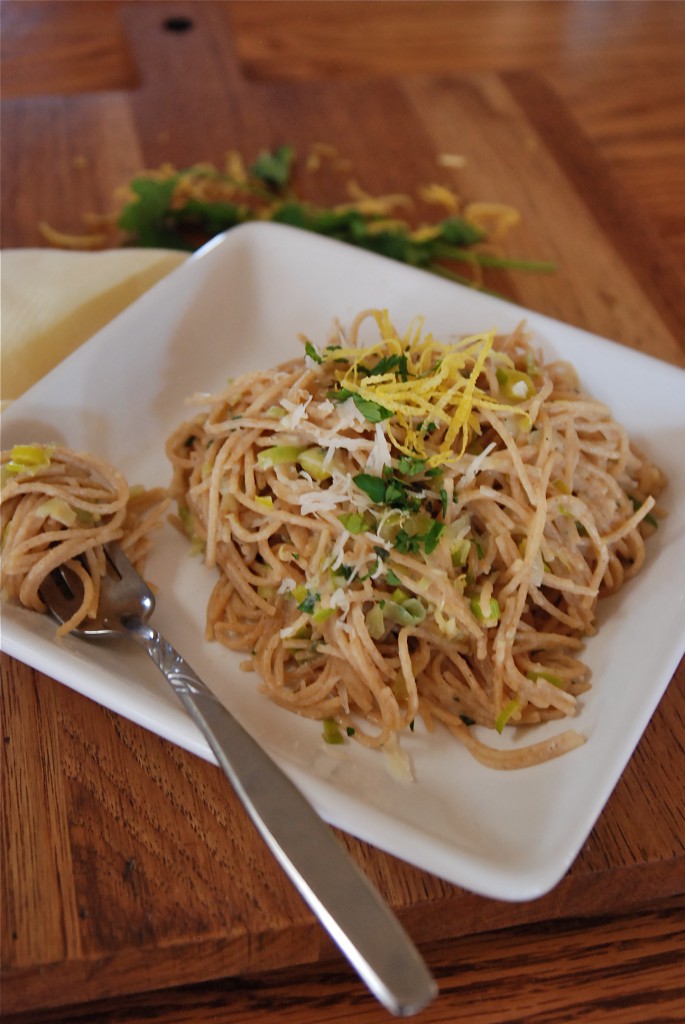
Eating anything with lemon in it is like ingesting sunshine, it’s so bright and engaging. This couldn’t be simpler to make, with a few leeks, a juicy lemon and a shower of fresh herbs, and parmesan cheese. I’ve done so much with lemons in my baking, like this Lemon Pound Cake, these intense Lemongrass Bars, and a delicious Lemon Ricotta Cookie, but adding sparkling citrus flavor to savory dishes has been few and far between, with maybe the exception of these exceptional Garlicky Lemon White Beans. That’s to an end though, after discovering this bright and lively pasta dish.
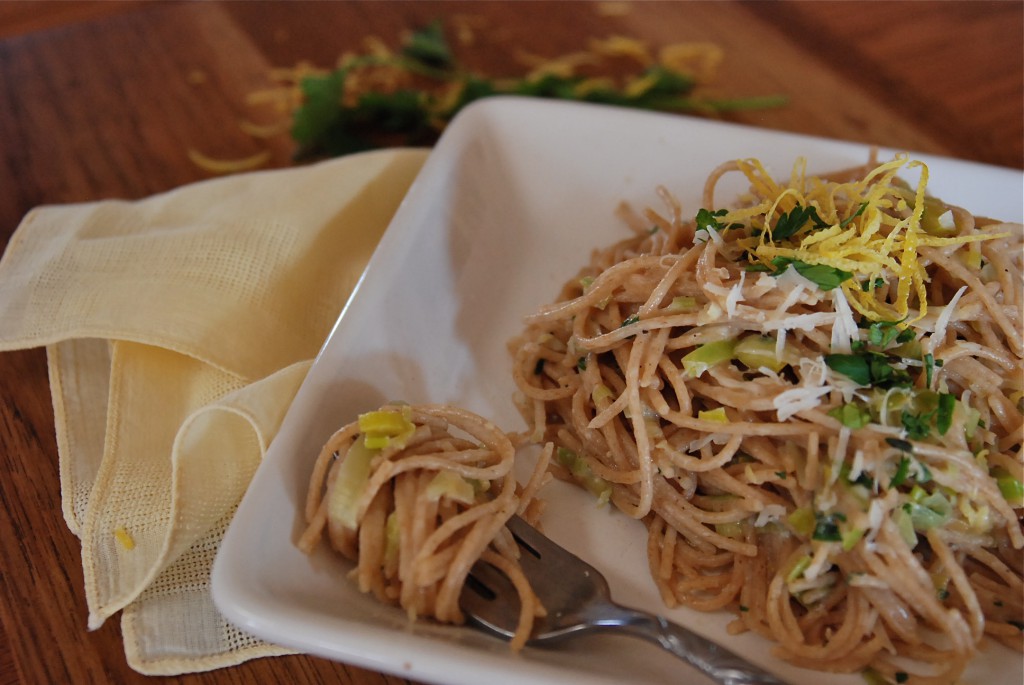
From the February issue of Eating Well magazine, resplendent with juicy lemon slices on it’s cover, this is a quick and easy recipe to put together. In the time it takes you to make a pot of pasta, you can have the leeks sauteed, ready and waiting. A few turns in the pan, with a splash of that ever-important pasta water and dinner is served.
Leek and Lemon Pasta
1# whole-wheat linguine or thin spaghetti
2 large lemons, plus lemon wedges for garnish
2 medium leeks (white and pale green parts only), thinly sliced and rinsed well
2 tablespoon extra-virgin olive oil
1/2 cup chopped flat-leaf parsley, divided
2 cloves garlic, crushed
1/4 teaspoon salt
1/8 teaspoon freshly ground pepper
3/4 cup finely grated Parmesan cheese, divided
1/4 cup snipped fresh chives, divided (I used thyme and it was delicious)
Cook pasta in a large pot of boiling water until just tender or according to package directions. Reserve 1-1/2 cups of the cooking liquid and drain the pasta in a colander.
Meanwhile, finely grate the zest from one lemon and squeeze juice from both lemons; set the juice aside. Pat leek slices dry. Heat oil in a large nonstick skillet over medium-high heat. Add the leek, the lemon zest, 1/4 cup parsley, garlic, salt and pepper. Cook, stirring frequently, until the leek is lightly browned and softened, about 6 minutes.
Add the pasta, 1 cup of the reserved cooking liquid, 1/4 cup of the lemon juice and the remaining 1/4 cup parsley to the pan. Cook, stirring constantly, until the liquid is mostly absorbed, 30 seconds to 1 minute. Add the remaining 1/2 cup liquid, or more lemon juice, if desired. Remove from the heat. Toss the pasta with 1/4 cup Parmesan and 2 tablespoons chives. Transfer to a serving bowl or bowls; sprinkle with the remaining Parmesan and 2 tablespoons chives and serve with lemon wedges, if desired.
Recipe in full, from Eating Well magazine, February 2012.
RECIPE NOTES: A simple reminder to yourself to catch the pasta water when draining it is to place a pyrex measuring cup in the bottom of your strainer when you put it in the sink. Pour some of the pasta water in it, set it aside, then drain the pasta completely. Another method, which I prefer, is to remove the cooked pasta from the water with tongs and add it directly to the skillet. It takes a bit of timing to get it right, but instead of draining all that beneficial starch away, it clings to the pasta and helps to create the pan sauce needed.
This dish would be wonderful with a broiled mild fish, such as Cod or Tilapia, some seared Scallops or Shrimp would also taste good. If you like chicken, a good lemon-herb rub and a run under the broiler would make a perfect accompaniment to this pasta.
January 27th, 2012
| 4 Comments »
January is drawing to a close and we’ve only just now received the first good snowfall to completely cover the landscape. And with only one brief cold snap, where temperatures dropped below zero for a day or two, it really just hasn’t felt much like winter at all. Still, the calendar doesn’t lie, the light still falls off before the dinner hour -although it gets later and later every day!!- and the hum of an oven, concealing something aromatic and delicious is still welcomed in any Minnesota home.
Lemon is everywhere right now. Those bright yellow orbs are certainly popular in the wintertime, bursting forth with that incredible fresh scent. Lemon is like sunshine, and not just from the sunny yellow color; that spritz of luscious lemony aroma that bursts from the rind when you cut into it is a wonderful tonic to the drab and gray of a winter day. I even feel sunnier eating lemon, like the light rays are just pouring through me. And citrus fruits are coming to the cold, lifeless mid-section of the country in all forms; gigantic globes of grapefruit, sunny tangerines, adorable little kumquats and key limes plus endless lemons.
I love to bake with lemon anything, and I particularly love the fresh zest paired with blueberries. But I have to admit that a lemon pound cake can make my knees weak. There is something about that tart bite, and the dense moist crumb that gets me, that makes it irresistible. But I’m not such a huge fan of the calories in pound cake, so finding a recipe that makes a lighter and less caloric version made me eager to try it out. But I had to ask myself…. would this even be worth it? We’ve all had those experiences of finding a less decadent way of baking a prized cake that simply falls flat. I couldn’t stand to be faced with a lemon cake that left me wanting more.
Needless to say, I was not at all disappointed.
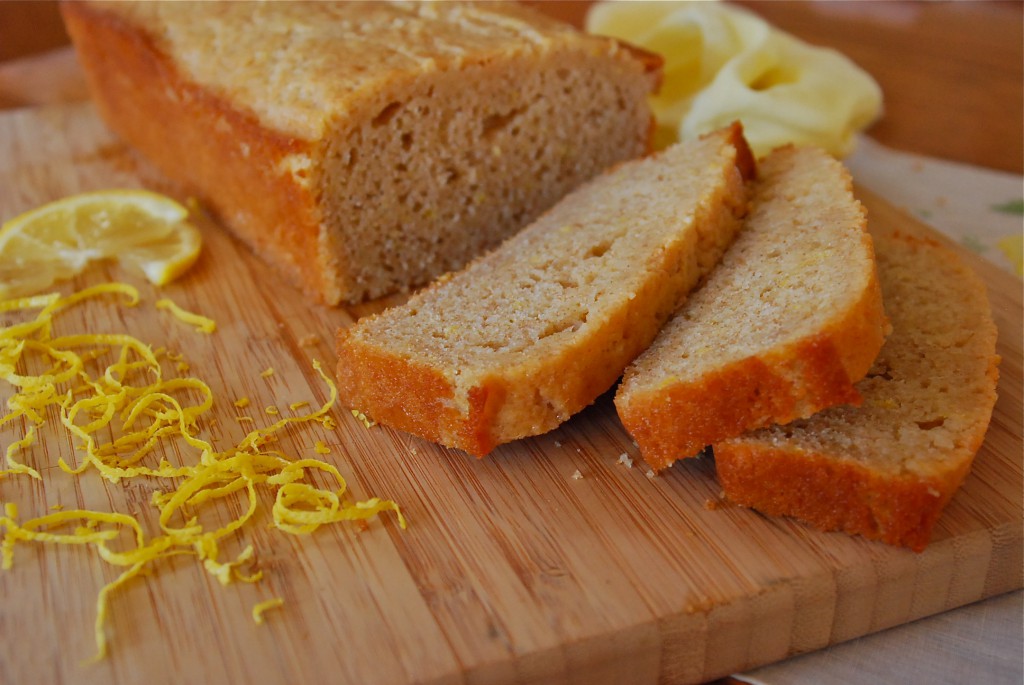
If you didn’t know that this cake wasn’t made with a ton of butter and sugar, you might not realize it at all. It still has that gloriously dense texture that’s rich and satisfying. It still shouts “LEMON!!” with every bite. It satisfies and satiates and makes for a luxurious treat that doesn’t leave you feeling too guilty. There’s a ‘just tart enough’ glaze brushed over the top of it to add even more of that lovely mouth-puckering taste, making the top of the cake nice and soft too, something I love about a good teacake.
The bright and sunny winter day even made the photos look like they were bathed in lemony light.
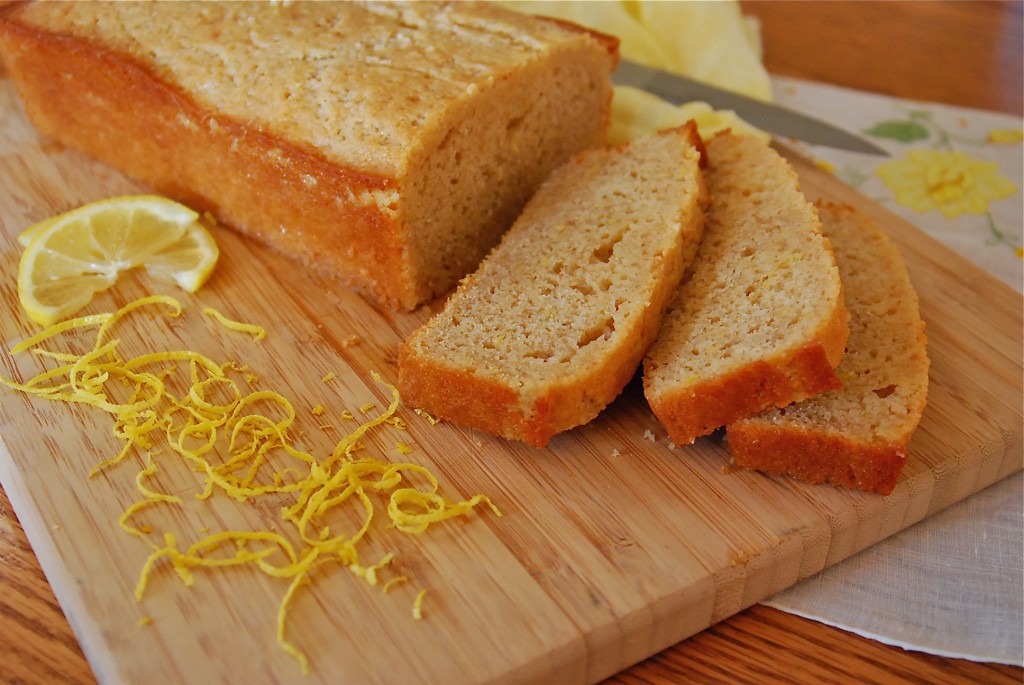
Lemon Pound Cake
- 1 cup whole-wheat pastry flour or white whole-wheat flour
- 3/4 cup all-purpose flour
- 2 teaspoons baking powder
- 1/4 teaspoon salt
- 3 large lemons, divided
- 1 1/4 cups sugar, divided
- 3 ounces reduced-fat cream cheese (Neufchâtel), at room temperature
- 2 tablespoons butter, at room temperature
- 3 large egg whites, at room temperature (see Tips)
- 1 large egg, at room temperature
- 1/2 cup reduced-fat milk
Preheat oven to 350°F. Coat a 9-by-5-inch (or similar-size) loaf pan with cooking spray; dust with flour and tap out any excess.Sift whole-wheat flour, all-purpose flour, baking powder and salt together into a medium bowl.
Finely grate 2 tablespoons zest from 2 of the lemons; set the lemons aside. Beat 3/4 cup sugar, cream cheese, butter and the zest in a large bowl with an electric mixer on medium-high speed until light and fluffy, about 2 minutes. Beat in egg whites, one at a time, beating well after each addition. Add the egg and beat well. Reduce speed to medium and beat in milk; the mixture will look curdled.
Reduce the mixer speed to low and add the flour mixture in 2 batches, beating just until combined and scraping down the sides of the bowl as necessary. Transfer the batter to the prepared pan and smooth the top with a rubber spatula.
Bake the cake until a wooden skewer inserted in the center comes out clean, 45 to 50 minutes. Cool in the pan on a wire rack for 15 minutes. Run a knife around the sides and turn the cake out onto the rack.
While the cake is cooling, squeeze 5 tablespoons juice from the zested lemons. Trim the ends off the remaining whole lemon and very thinly slice; discard any seeds. Heat the lemon juice and remaining 1/2 cup sugar in a small nonstick skillet over medium heat, stirring until the sugar is dissolved. Add the lemon slices and cook, stirring frequently, until softened, about 5 minutes. Reduce heat to maintain a simmer. Use a fork to transfer the lemon slices to a bowl. Continue simmering the syrup until slightly thickened and beginning to turn golden yellow, 2 to 4 minutes
Set the rack over a rimmed baking sheet. Poke holes all over the top of the warm cake with a wooden skewer, 1 1/2 to 2 inches deep. Spoon the glaze over the cake, poking more holes if the glaze does not sink in. Arrange the lemon slices on top. Let the cake cool completely before slicing.
Recipe Notes: I made my cake with the glaze, and not the candied lemon slices. I tried, but they fell apart in the syrup and looked strange so I didn’t put them on the cake. The glaze was good, but I think the cake doesn’t really need it either.
Recipe from Eating Well magazine, posted in original form.
March 20th, 2011
| 7 Comments »
More sugar. Must be winter’s end…..
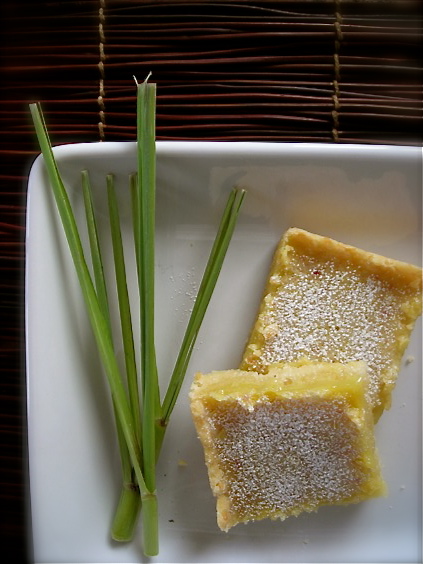
I’ve been lamenting a lack of fresh foods lately. The transition season is approaching rapidly; that between the depths of winter when root vegetables and long slow aromatic braises seem to be the elixir we all need to the first snap of green vegetables that promise warmer days and less outerwear. March comes along and it’s like we all draw a long slow breath, eagerly awaiting the day where the very air shifts and the warmth blows in and we forget about 85″ of snow, the endless drifts, the nerve-wracking commutes. Our winter has been memorable, and it’s a noticeable grimace when flakes continue to fall and the slack jaws at the produce counter scan the same old, same old and try to drum up a different beat for those carrots, the sweet potatoes and rutabagas.
For me, some respite came with one definitive twist of a channel knife, cutting through the thick zest of a fat lemon and releasing the minuscule spray, that spritz of aromatic citrus that at once says to my weary winter white brain ‘Sunshine!’ ‘Warmth!’ Because we all know that those golden orbs carry the very essence of the sun within their tart flesh; with a firm grip they release their juice, carrying an altogether different sensation to our nose. The white of winter, the stinging scent of a fresh snowfall and a glacial chill in the air is quite distinctive, and it settles into us with a thud as those flakes fall, fall and fall, but among that endless snow, the never-ending white, I twisted up a bowl of lemons, ground the zest off their hides and, in addition to all that sunshine filling my kitchen (if I closed my eyes I could see white sand, a hammock and the blue of the Caribbean) I crushed up three stalks of lemongrass, with it’s sharp citrus-y aroma and racy bite and turned it all into the most amazing and tantalizing Lemon Bar I’ve ever had the pleasure of biting in to. Spring is a tease in March; we have days of sunshine, fickle sun, torrents of rain and then a bone-chilling wind descends to remind us that we’re not quite out of the woods yet, so finding this Lemongrass Bar recipe in the current Bon Appetit, with it’s crumbly tender Coconut Shortbread crust was a perfect tonic for the weary landscape of white that turns gray and gritty as we slip through the doorway to another season.
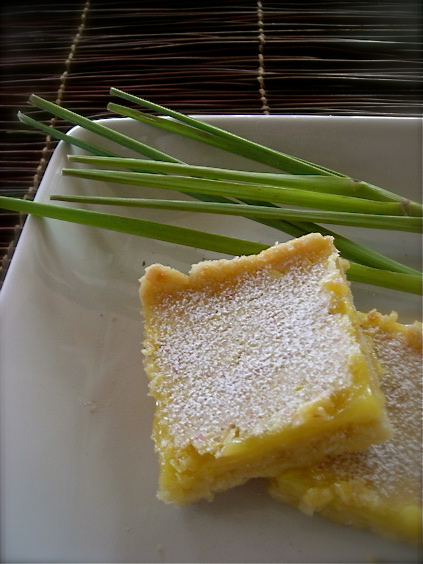
And yes, sugar. Sweet sugar and the tang of lemon, but cut with the flavor of lemongrass, a perennial grass native to the Philippines. Widely used in Asian cuisine is soups, teas and curries, it’s suitable for all meats, and can be made into lemongrass oil which is used as a pesticide and preservative, and is known to have anti-fungal properties. I’ve used lemongrass in savory recipes and love the simple flavor it adds, but the addition of it to these Lemon Bars was genius; the tender white bulb is ground fine with your sugar, then blended with eggs and a little flour to create a luscious filling. The bonus to these bars? Coconut in the crust.
Recently I was given several bags of sweetened shredded coconut that I tossed in the freezer to await inspiration. I do love coconut, but find the sweetened version too overwhelming to add to my oatmeal or muffins as I prefer, but in this recipe, cooked into a tender buttery shortbread crust, it was perfect. With the addition of the lemongrass in the filling, adding an extra level of flavor but without the cloying teeth-clenching sweetness of your standard Lemon Bar, these offered up a nice dose of Springtime to push all thoughts of late Winter faster to it’s timely demise.
Lemongrass Bars with
Coconut Shortbread Crust
Crust:
1-1/2 c. AP flour
1 c. sweetened shredded coconut
1/2 c. powdered sugar
1/2 c. (1 stick) unsalted butter, slightly chilled and cut into chunks
Filling:
1-1/4 c. sugar
3 lemongrass stalks, bottom 4 inches only, tough outer layer removed & finely chopped
6 T. fresh squeezed lemon juice
2 t. fresh grated lemon zest
3 large eggs
1/4 c. AP flour
Heat oven to 350° and spray a 13×9 cake pan with cooking spray.
For the crust, whisk flour, coconut and powdered sugar together, add butter and cut butter into mixture until it resembles fine crumbs. Use a pastry cutter, two forks or knives or your bare hands. Press dough onto bottom, and 1/2″ up sides of prepared pan. Bake crust until golden (edges will darken more) about 20-25 minutes.
For filling: Place sugar and lemongrass in food processor and blend until finely ground, about a minute. Add lemon juice and zest, pulse 3-5 times. Add eggs and pulse to blend. Add in flour, and a pinch of salt. Blend until smooth.
Pour filling over hot crust. Reduce oven to 325° and bake until filling is firm, 20-25 minutes. Cool bars completely in pan then cut to desired shape. Dust with powdered sugar, if desired, before serving.
Recipe: Bon Appetit magazine (with small modifications)
September 7th, 2009
| 3 Comments »
I’m not sure why, but I’ve been rather shy about mint in my cooking career. Did I have a traumatic experience with mint at some point in my life? The overdose on wintergreen Life Savers that I went through as a child? Why has mint not been forefront in my culinary dishes?
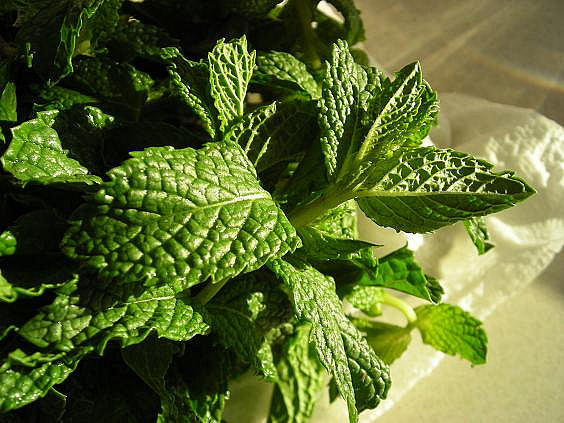
I haven’t an answer, but as of late, I seem to be making up for lost time on the mint appreciation. It’s been all over the place.
I love it muddled in a glass with chilled green tea poured over it. I’ve shredded it into salads and sprinkled it in pilafs. I ate some over sweet melon chunks, sighing in contentment at the contrast in flavors. It’s wonderful mixed with fresh oregano in any corn dish (hint: leftover cooked fresh corn, cut from it’s cobs needs nothing more than fresh oregano, fresh mint, a drizzle of olive oil and some salt and pepper. Toss it on a salad. You’re welcome)
Mint has been a regular in my fridge as of late and I’m only just beginning to understand the reaches to which this herb can go. A huge thick bunch is about $1.50 at the grocer, and wrapped in a damp paper towel in a plastic bag, it lasts for quite some time in my fridge. The last thing I ever thought I would be doing would be eagerly and gleefully searching out recipes that will include mint. Or making them up, as it turned out. Like this Lemon Mint Potato Salad with Green Beans.

I browse hundreds of food sites, recipe sites and food information in any given week. I am always undertaking a study of food in all it’s glory from the amazing array of food blogs both stellar and odd, to the sites that talk food, culture, nutrition and diet. I know that somewhere in my browsing I came across a dish similar to this because it’s the only way I can think that it got into my brain at some point, and the mere action of holding onto a bunch of mint at the grocer made it jump front and center, to the spot where all my creativity pours out. It’s rare that I really smack a home-run the very first time creating a recipe from scratch, but this one worked. On all levels. The crunchy beans, moist potato and superbly tart and lemony dressing, with hints of mint and dijon mustard come together in a lovely symphony of simplistic eating. I was sad when I was full.

Lemon Mint Potato Salad with Green Beans
by Kate
1# ‘B’ Red potatoes, quartered and steamed to tenderness
1/2# fresh green beans, blanched and shocked to cool
1/2 c. fresh mint leaves, washed and dried
Juice of half a lemon
2 t. lemon zest
1/4 c. olive oil
1 T. dijon (or other brown, deli style) mustard
1 oz fresh goat cheese, crumbled
Salt and pepper
Place potato and beans in a medium bowl. In a small measuring cup, whisk together lemon juice, lemon zest, olive oil, mustard, goat cheese and 2 T. of the mint until smooth and creamy. Season to taste with salt and pepper. It will be very tart and lemony, with a subtle mustard zing. Pour over potato mix and gently stir to coat. Serve room temperature or chill for an hour or more before serving. Top with mint leaves and extra salt and pepper before serving.
SIDE NOTE:
The kind folks at Ile De France cheese regularly send me free cheese to try at home, and I am very grateful for their generosity. The goat cheese used in this recipe is one of their offerings, a 10.5 oz chunk that is fresh and flavorful, with a subtle hint of herb and grass and a terrific texture that crumbles easily, melts superbly and whisks smooth in any number of options. It lasts for a good long time wrapped up properly. Thanks so much Ile De France!!

|













